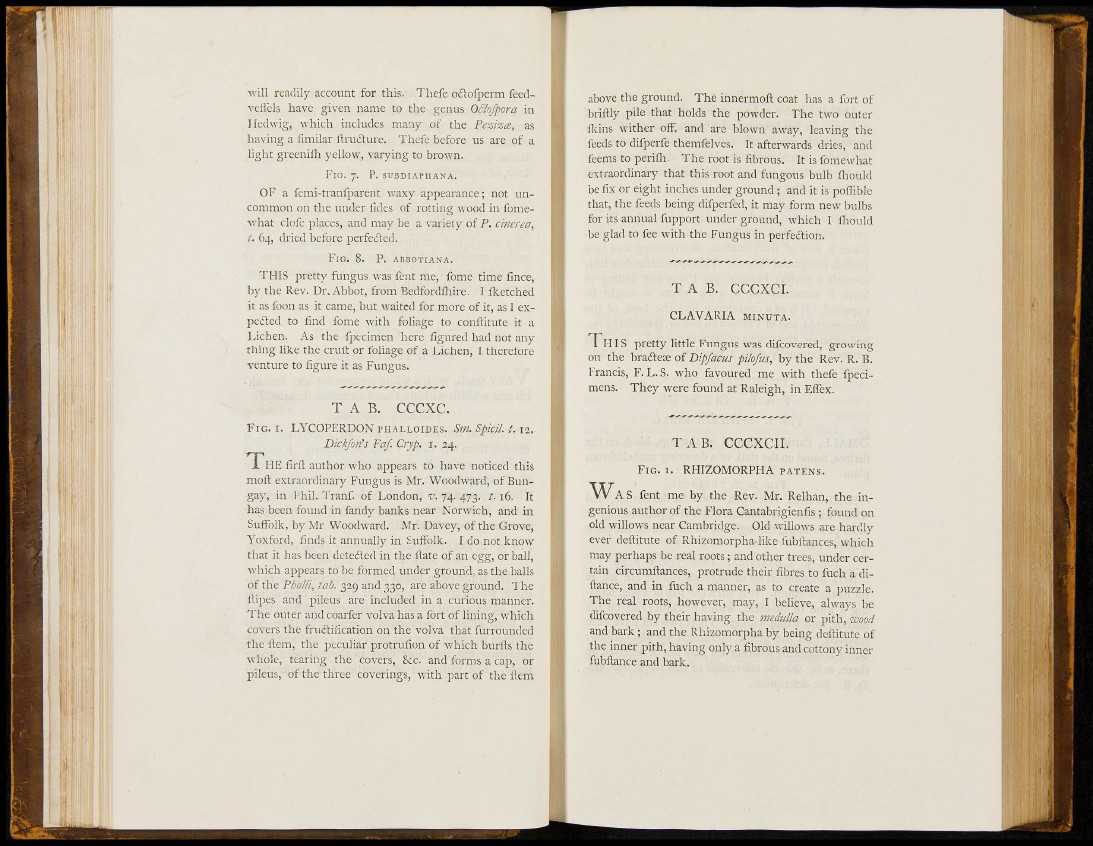
1:4 . (
M'ill rcadil)'- account for this. Tliefe oilofperm feedveflels
have given name to the genus OBoJpora in
lledwig, which includes many of the Peziza, as
having a fimilar ftruiture. Thefe before us are of a
liglit greenifli yellow, varying to brown.
FIG. 7. P. SUBDIAPHANA.
OF a femi-tranfparent waxy appearance; not uncommon
on the under fides of rotting wood in fomewhat
clofe places, and may be a variety of P. cinerea,
t. 64, dried before perfeited.
F I G . S. P. ABBOTIANA.
THIS pretty fungus was fent me, fome time fince,
by the Rev. Dr. Abbot, from Bedfordflrire. I iketched
it as foon as it came, but waited for more of it, as I expcdfed
to find fome with foliage to conftitute it a
lichen. As the fpecimen here figured had not any
thing lilce the cruft or foliage of a Lichen, I therefore
venture to figure it as Fungus.
T A B. CCCXC.
FIG. I. LYCOPERDON PHALLOÏDES. Sm. Spicil. t. 11.
Dickforís Faf. Cryp. i. 24.
T H E firft author who appears to have noticed this
moft extraordinary Fungus is Mr. Woodward, of Bungay,
in Phil. Tranf. of London, v. 74. 473. t. 16. It
has been found in fandy banks near Norwich, and in
Suffolk, by Mr. Woodward. Mr. Davey, of the Grove,
Yoxford, finds it annually in Suffolk. I do not know
that it has been detefted in the ftate of an egg, or ball,
which appears to be formed under ground, as the balls
of the Phalli, tab. 329 and 330, are above ground. The
ñipes and pileus are included in a curious manner.
The outer and coarfer volva has a fort of lining, which
covers the fruftification on the volva that furrounded
the ftem, the peculiar protrufion of which burfts the
whole, tearing the covers, &c. and forms a cap, or
pileus, of the three coverings, with part of the item
above the ground. The innerniofl coat has a fort of
briftly pile that holds the powder. The two outer
flcins wither off, and are blown away, leaving the
feeds to difperfe therafelves. It afterwards dries, and
feems to perifli. The root is fibrous. It is fomewhat
extraordinary that this root and fungous bulb fliould
be fix or eight inches under ground ; and it is poifible
that, the feeds being difperfed, it may form new bulbs
for its annual fupport under ground, which I flrould
be glad to fee with the Fungus in perfection.
T A B . CCCXCI.
C L A V A R I A MINUTA.
T H I S pretty little Fungus was difcovered, growing
on the braitea: of Dipfacus pilofus, by the Rev. R. B.
Francis, F. L .S. who favoured me with thefe fpecimcns.
They were found at Raleigh, in Effex.
T A B . CCCXCII.
FIG. I. RHIZOMORPHA PATENS.
W A S fent me by the Rev. Mr. Relhan, the ingenious
author of the Flora Cantabrigienfis; found on
old willows near Cambridge. Old willows are hardly
ever deftitute of Rhizomorpha-like fublfances, which
may perhaps be real roots; and other trees, under certain
circumftances, protrude their fibres to fuch a diftance,
and in fuch a manner, as to create a puzzle.
The real roots, however, may, I believe, always be
difcovered by their having the medulla or pith, wood
and bark; and the Rhizomorpha by being deftitute of
the inner pith, having only a fibrous and cottony inner
fubftance and bark.